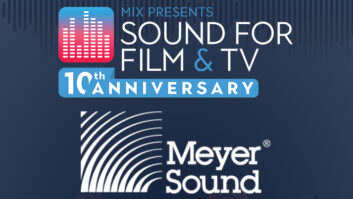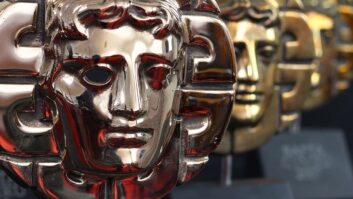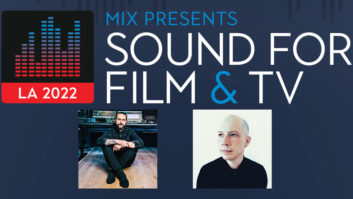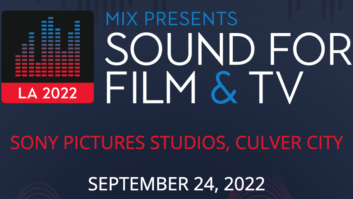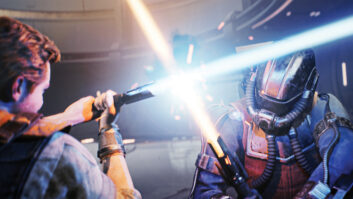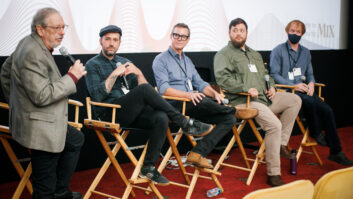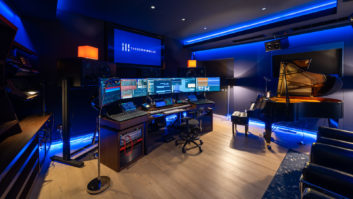Some of the greatest themes in film music-like “Lara’s Theme” from Dr. Zhivago or “Also Sprach Zarathustra” from 2001: A Space Odyssey-have cemented key cinematic scenes in movie-goers’ minds, helping to elevate the films to classic status. How would The Godfather resonate without Nino Rota’s memorable score, or how would Jaws play without John Williams’ terrifying hook?
It has been said that music is the great manipulator in film, bringing an emotional pull to pictures. But composers are not puppet masters. What they add, what they enhance, begins with what’s on the screen.
To offer some insight into the way today’s composers approach their film projects, Mix interviewed Danny Elfman, Michael Kamen, John Ottman and Trevor Rabin. As would be expected, these artists have had years of formal training, but it is noteworthy that three of our contributors also came from rock careers.
DANNY ELFMANBefore Danny Elfman began scoring films, he was the front person for the quirky eight-piece L.A.-based pop band Oingo Boingo. In the mid-’80s Elfman began what has been an ongoing body of soundtrack work with director Tim Burton. The first movie they did together was Pee Wee’s Big Adventure, followed by Beetlejuice, Batman, Edward Scissorhands, Batman Returns, The Nightmare Before Christmas and Mars Attacks! Other Elfman soundtracks include Men In Black, Mission: Impossible and Scrooged.
I’ve found that trying to come up with ideas from the script has always backfired. The score, for me, is dictated by the way the images are laid out. The movement, the pacing, the timing and how the cameras are positioned help dictate this. Other than the common denominator of whether it is going to be a romance or an action film, or a fantasy, you can take the same script and make 20 different movies out of it, and that, for me, would require 20 different scores.
What works best for me is to look at my first rough cut of the movie with absolutely no preconceptions of what I’m going to do. In other words, the more blank I can make my head, the better it is going to be for the project.
So the first level of my process is the initial impression of a musical piece. Now I’ve got something-a theme, or motif, or rhythmic feel-that I think is going to work. The next part is really hard because it is about really applying it to the film, and that involves watching it a lot.
I will take half-inch viewing cassettes to my bedroom, to my studio, watch them in my den. I start coming up with lots of ideas and recording them and trying them out and moving them around and coming up with more variations. It is kind of a maddening process, because then I get to a point where I have too many ideas and I have to see how this idea will fit next to that idea, and how they can go together. I can’t start actually writing the score until I’m very confident that I have all of the pieces to the puzzle laid out. Now, I don’t know how they are going to fit together exactly, but getting those components all ready and laid out and knowing that A fits next to B and that fits next to C is the hardest part of scoring to me.
It is good to know that the technical stuff doesn’t make the score. It helps with the presentation, and directors really want that nowadays, but it still hasn’t changed the fact that the art is still the art, and it is still about capturing tone. And capturing the tone is probably the most important thing you are going to give the film.
In a way, writing a good score is the easy part of scoring. Convincing a director to let you write a good score, and to actually use it, is almost more work than writing it.
I would say that it helps these days to be equal parts composer and psychologist. The reason I’m so loyal to people like Tim Burton and Gus Van Sant is simple. They just let me do my work. I have done some wonderful work with Tim. Why? Because he lets me. If [a director] tries to micromanage every bar of music, you don’t get a brilliant score. Period. If you make the composer spend all of their time trying to mimic what you are hearing in your head, you don’t get a brilliant score.
Many directors have a tendency to look at their movies scene by scene, and not as a whole movie with a beginning, middle and end over the course of two hours. If you looked at the whole film, as opposed to every three minutes being a world unto itself, that you have to push to its maximum, the film would be better served. I don’t blame the sound design for creating too many loud effects, one after another after another, any more than I should be blamed for too many crescendos or big musical cues, one after another.
MICHAEL KAMENDuring the late ’60s, Kamen was part of the New York Rock & Roll Ensemble, a group that was pioneering the synthesis of rock with classical elements and could count people like Leonard Bernstein and Jimi Hendrix among its fans. Since the ’70s, Kamen has enjoyed an incredibly successful film scoring career, including unusual works like Terry Gilliam’s Brazil and The Adventures of Baron Von Munchausen, and action blockbusters like Die Hard and the Lethal Weapon series. Recent credits include What Dreams May Come, 101 Dalmatians and Mr. Holland’s Opus, which was a special project for Kamen, as it resonated deeply with his own experience with a teacher-mentor. As a result, Kamen founded the Mr. Holland’s Opus Foundation, whose aim is to raise money and acquire instruments for school music programs.
I had a teacher in high school, the High School of Music and Art, who was my model for Mr. Holland. His name was Morris Lawner, and he gave me one word that was the greatest music lesson of any. He said, “All great melodies share one feeling, and that is a sense of inevitability; the ‘inevitable’ result of the phrase that came before it.” That word ‘inevitable’ has never left me to describe an unerring sense of correctness to brilliant pieces of music, and why a melody works. I apply that every day, when I sit down with my Bach and my Brahms and try to be “inevitable.”
Another key lesson came from Manos Hadjidakis, who wrote “Never On Sunday.” This man was an uncommon musician. He had really stupendous talents of creating very elegant, ethereal and deeply beautiful melodies. He understood music. One time, he admonished me after listening to a composition that I was working on. He said, “You must never write on the piano.” I was disappointed, because at that point, I was always writing on the piano. I said, ‘Why not?’ And he said, “You’ll become a prisoner of your technique.” And that phrase has stuck with me every day. If you can only write what you can play, you’re going to really be limited.
I do a lot of work on an Apple Powerbook G3, and I have a desktop G3 as well. I love the new flat screen. I still use Performer, but when I do a major work for an orchestra, I tend to do it with paper and pencil. I still believe that the brain is more comfortable manipulating that kind of data that way.
This is a very complicated commercial business, and if you are trying to make “art,” you have to recognize that you’re making art as commerce and decide for yourself if you want to pay attention to it, or just make “art.” I started out in Robin Hood, for example, insisting on using 12th-century instruments. To me, that seemed to be a really imaginative idea-that we could be a wonderful noise that way. But the company’s view of 12th-century music was that it was probably too light to support a film like that. So they said, “If we see any crum horn players heading into the Warner Bros. lot, we are going to shoot them on sight.” [Laughs] I’m certainly walking the line between art and commerce-I feel I’m an artist, and I love the result of the commerce.
Music, when it communicates anything at all, is communicating emotions. Very often, it appears that films allow music to become kind of a commodity, like a sound effect, and you watch sort of generic music for action-adventure movies or even love stories, and you realize that the thing that is missing is the real heart of the score, the piece of music. I feel responsible to the overall legacy of music that I come from, to make music that’s real and well-intentioned and is actually trying to express some little corner of a human being, if not the whole person.
JOHN OTTMANJohn Ottman is in a unique position: He is also a film editor, which allows him a lot of control in helping shape the musical elements of the films he scores. Ottman’s scoring and editing credits include The Usual Suspects, The Cable Guy, H2O, Public Access and Apt Pupil.
The music is really the soul of the film, and the best scores will tell a story on their own. With some exceptions, if you [listen to] a really good score away from a film, you will actually hear a story being developed and themes being hinted at and, later, coming into fruition. That is a really well-thought-out score.
One of the most important things in storytelling is making sure you have peaks and valleys. There are areas where there should not be music. The fear of many producers today is that, the moment there is any silence, the audience is going to leap up and run out of the theater. So, composers are often asked to score every moment. You have music now that is simply seen as an adrenaline-pumping mechanism, as opposed to a storytelling device.
I’m one of these people who is barely on the threshold of understanding his equipment. All I do is use it, and I have some tech come and set it up for me. I’ve got an 8100 Power Mac that was basically outdated the second I bought it. I use Performer, and I have four 760 Roland samplers. I have a Korg TR rack sound module, a Korg O1RW sound module, a Korg X3R, an old Proteus FX and a Roland JD-1080. I’ve got a Roland R-8M. My keyboard is a Roland D-70. I have an old Ensoniq ASR-10 sampler. I have a Tascam DA-88 and a Mackie 32*8 mixing console, plus a couple of Lexicon reverb units.
I have this psychotic mission to do things differently. For instance, with H2O, we had this huge score that we did with an orchestra. We mixed it in the back of someone’s garage. You would never know that. It doesn’t matter where you are and what you are doing. It just matters how you are doing it.
With The Usual Suspects, we recorded that score seven times with each section of the orchestra recorded separately. I’ll stack the strings up, and then it sounds like there is this massive-sounding string section. The great thing about that approach is that it gives you complete control in the final mixing because you have the groups of strings on separate tracks.
We also recorded the score with no picture. Since I was the editor, I already knew the picture very well. We just recorded the score and plugged it in with the SMPTE, and it fit in like a glove. [Laughs] You know, you can break the rules. Everyone feels like they have to hold allegiance to the rules of the game, and it seems like they sometimes forget what it is like to be creative, when they started out.
TREVOR RABINAt the outset of the ’80s, English prog-rock group Yes was enjoying a major comeback, thanks to hits like “Owner of a Lonely Heart,” “Rhythm of Love” and “Leave It.” Trevor Rabin, a newcomer in this legendary band, was a key ingredient in writing these hits. Then, after years of recording and touring with Yes, Rabin jumped into the world of film music and has enjoyed substantial success with films like Armageddon, Con Air, Homegrown, Enemy of the State and, most recently, Jack Frost.
On all the stuff I’ve done with Jerry (Bruckheimer)-and I’ve done the last three movies and a TV show for him-I read the script and see some footage and go for a drive and think about it and hum stuff to myself. I’ll play the piano, go for a walk and come back and think more about it. And then I’ll sit down and start writing themes, like a little suite, just to give an idea of how I see the movie. This is without tying it to footage at this point. Once you’ve got that and the feeling is, “Yeah, that’s the right feel,” you’ve already won the battle of the “temp” because your theme is now being accepted.
A temp score should be used to give an idea of the best efforts of the music editor, to show you where the director is hoping to go emotionally and rhythmically. When it gets to a point where you are a slave to the temp, it is a very dangerous place to be. That is why I like to solidify the themes, so they can eclipse the temp score pretty easily. Then my music editor will put down a comprehensive spotting list together of the cues, and I’ll start locking to picture. That only happens when I have established the themes.
I have a couple of dozen E-mu E-IVs and about a dozen Roland 76s. As far as synthesizers go, I love the Korg stuff. It is pretty much all I use. When I’m writing, I basically record at home. I never record the MIDI information to tape. I just leave it and do everything in the computer, which is an Apple G3. I use Digital Performer, which has a really great time-stretching or tuning device.
When writing music, you sometimes need to take the keys of the source music songs into consideration. Quite often, you will need to merge into that song and merge out. Sometimes it is a clean break.
With one of the Jack Frost tracks, source was an old Cole Porter song called “Every Time I Smile.” Since Michael Keaton was a blues player and singer in the movie and the song was a jazz standard, there were guitar fills that I thought would work great if I introduced more of a blues feel, which was actually quite a challenge because the chords don’t lend themselves really to down and out 12-bar blues. I had to redo the song because it was really imperative for the movie, and there was no existing version of the song that was appropriate.
Other times, I like to come up with things that play against the picture. If you hit every sting, it becomes very predictable and you are telegraphing everything that is about to happen. Sometimes, it might be that I let the music tell people that things are going elsewhere, so that when things go to where they are supposed to go, it is a surprise.
Over the past few years, a number of labels have begun using the soundtrack album to push their latest priority pop acts. These “soundtrack” albums are often packaged as “music from and inspired by the movie fill in the blank.” Fortunately, there is also a growing awareness of and market for releases that feature the film composer’s music, and many labels have begun restoring and repackaging classic scores. Recently, Rykodisc, a label known for its integrity and commitment to quality, began reissuing a series of primarily ’60s and ’70s soundtracks from the United Artists vaults in a joint venture with MGM.
This seven-year project, which offers approximately 100 soundtrack titles, covers everything from symphonic to pop and children’s music to jazz. Among the titles are classics such as Never On Sunday, Last Tango in Paris, Some Like It Hot, Equus, Lenny, Carrie, Man of La Mancha, The Pink Panther Strikes Again, and chestnuts including Here We Go Round The Mulberry Bush (with the Spencer Davis Group and Traffic) and Duke Ellington’s music for Paris Blues.
“We have worked very hard to track down the very best source we can, and sometimes we have gone to great lengths to do that,” says Northeastern Digital Recording’s Dr. Toby Mountain, who remastered the lion’s share of the titles with assistance from Malcolm Addey. “I think we have focused our efforts on projects that do have better source material. In some cases, we have some very good sources, including original 3-track tapes.”
One of the soundtrack releases that seemed to elicit the most pride from those involved is a three-CD set of Alfred Newman’s Oscar-nominated score for the 1965 George Stevens-produced film The Greatest Story Every Told.
“Disc One is actually the original score album, and, as was the fashion in those days, it was a re-record done for the record. That is sonically superb,” states Ryko MGM product manager Ian Gilchrist. For Disc One, Ryko had the original 3-track, but for Discs Two and Three (which feature never-before-released versions of the original film recordings), he obtained second-generation tapes from the library of Newman’s assistant and orchestrator, Ken Darby.
In organizing the presentation of that music, Ryko employed the services of film music consultant Ray Faiola, whom Gilchrist described as “very knowledgeable about this film. He adored it and he helped us put it together. What we were trying to do was to take this music from the original scoring reels and make the cues flow together, so that it sounded like you were listening to a symphony.”
One of Ryko’s more recent MGM releases is the soundtrack to Arlo Guthrie’s classic, Alice’s Restaurant. “MGM sent me all of the tapes that they had, and in most cases, they were 1-inch 8-track,” says Mountain. “I had to go through all of the material and weed out the bonus material and decide what was actually used on the soundtrack and remix it. It took several days, but I’m pretty happy with the way it came out, and Arlo Guthrie liked it, too.
“A lot of people don’t know that the version that was popularized on the Warner Bros. release was a different recording than the one in the movie,” Mountain adds. “When they went to make the movie, United Artists made Arlo re-record ‘Alice’s Restaurant’ as a two-part thing, because they wanted it on Side A and Side B. They didn’t want one side of the album to be lop-sided. With Arlo’s permission, we actually remixed the song and put the two parts together, because he wanted them to be one part.”
Ryko has also included enhanced audio/visual components with each release. Often, the enhanced element consists of an original film trailer or an action scene (with 8-bit compressed audio) from the movie. Ryko director of new media Lars Murray oversaw the implementation of the enhanced elements, which are playable in Mac and Windows formats. “Essentially, when we looked at the whole series, we realized that there was going to be a lot of trailers that we could use, and a lot of these trailers would be interesting to collectors,” Murray says. “There really isn’t that much of an outlet for these trailers, and you are not likely to run into them anywhere, so we thought these would be a nice addition, like liner notes or extra photos, to the package.”
“There is a hardcore niche of soundtrack collectors who are into classical soundtrack score music,” Gilchrist adds. “These fans are a very vocal, knowledgeable bunch, and they don’t take very kindly to second-rate product or bad re-records. They are really passionate about music. With this catalog of titles, there’s jazz, soul, pop, country-it is really varied, encompassing all kinds of musical idioms. That is one big thing that was appealing about it. But everything that is here on these releases, should reflect, in my mind, the fact that it is a movie that we are dealing with here.” -Rick Clark
There’s nothing like a nice cappuccino in New York City. Have a sip, talk about maybe scoring a film. Take another sip, find out you got the gig. Just as you’re pulling the demitasse cup to your mouth one last time, you find out you’ve only got three weeks to write and record the score. Gulp. Welcome to Robbie Kondor’s role in Happiness, the film he scored late last year that won the International Critic’s Poll at the 1998 Cannes Film Festival for director Todd Solandz.
As if that weren’t enough, Kondor had already committed himself to a solid week of work, composing music for clients like Xerox and HBO for national television spots. On Happiness he was given three weeks with a limited budget and a director who was in the studio every other day to see how things were going. Ready, set, go.
To optimize his time, Kondor used his own Midtown New York City studio (profiled in Oct. ’97 Mix). Because he’s a keyboard player from way back (he jokes that he started playing synthesizers when guys in white lab coats were using them to make novelty noises), Kondor used a Kurzweil 2500-X and E-mu E-64 with modules including Roland’s JV-2080, JD-990, U-220 and R-8M (for drum and percussion sounds), and Voce’s V3 Organ module. Kondor used to travel with rack upon rack of gear, but he has stripped his equipment list down considerably.
“Really, I must say, I get it done with the Kurzweil, the E-mu and the 2080. I think that’s interesting because I was the synth guy,” he explains. “I’m not sentimental about ‘this one does this sound and that one does that sound.’ It’s like a 2080 can do kind of any sound and a 2500 can do kind of any sound. A couple of ’em have 64 voices, and one has 128 voices and I’m not running out of sounds, I’m not running out of voices. I like keeping it simple.”
While he tacks down his ideas on the Kurzweil, using both Digidesign’s Pro Tools|24 system and MOTU Digital Performer 2.42, on a Macintosh 9600, he prefers to bring in live players whenever possible. In fact, he says, occasionally a project can get done faster and closer to budget with musicians. “For example, if I had to do a nice swing and jazz band, I could program that and have it sound convincing,” he explains. “I might spend a long time, or I might write out a chart in not too long a time. But once you get in a room with the right five musicians-probably booking the studio and making the arrangements and getting a copyist takes longer than recording the music-you’re out of there in a half hour. I could spend a half hour looking for the right acoustic bass patch or trying to EQ it till I like it. If the music is written and you know what it’s supposed to sound like and you have it committed to paper in the right way-that’s to say not too detailed nor too lacking in detail-it comes together quickly and beautifully.”
For the Happiness scoring sessions, Kondor had a handful of live players come in to add overdubs to the tracks he had written with Solandz’s assistance. Joining Kondor’s sampled piano were a pair of guitarists, a percussionist, and players contributing English horn, oboe, violin, cello, trombone, flute, saxophone and accordion. He delivered the project on both Tascam DA-88s and DAT. Usually, he split the percussion tracks out on the DA-88s just in case the instruments were conflicting with sound effects or dialog, though it turned out the re-recording team generally used the stereo DAT mixes Kondor supplied
